If you’re eager to start playing checkers but aren’t sure of all the checkers rules, this page should clear it up.
Rules of Checkers
Here are the standard checkers rules divided into sections for easy reference.
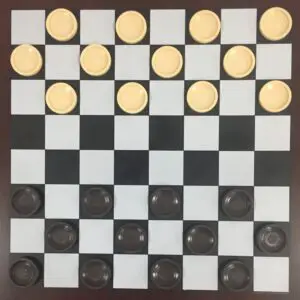 Checkers Rules: The Set Up
Checkers Rules: The Set Up
- The board is oriented so that a light square is in the near right corner for each player.
- Each side starts with 12 “men” or pieces which are placed on the three rows of dark squares on their respective sides of the board.
- Only the dark squares are used.
- One side plays the dark pieces and one plays the light pieces. Common colors combinations include black/white, black/red, red/white and brown/beige. The pieces can be referred to as black and white regardless of what colors they are.
- Black always moves first.
- Players alternate moves.
- Who plays black first can be decided arbitrarily or by the winner of a coin toss. In subsequent games, players alternate going first.
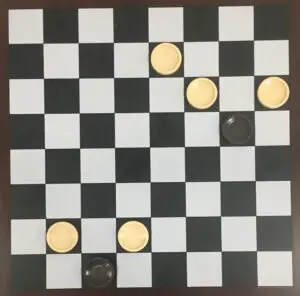 Checkers Rules: The Regular Pieces
Checkers Rules: The Regular Pieces
- Regular pieces can only move and jump diagonally forward.
- Regular pieces can move 1 square diagonally forward to the left or right if the square is empty.
- Regular pieces can jump an enemy piece or king on a diagonally adjacent square going forward if the square behind the enemy piece is empty. (picture) The black piece on the bottom left can jump either white piece in front of it because the squares behind them are empty. The black piece on the right can’t jump or move.
- Pieces can jump regular pieces and kings.
- Pieces can’t jump their own men or friendly kings.
Checkers Rules: The Kings
- A regular piece that moves or jumps into the opponent’s back row (king row) becomes a king. The opponent places another piece on top of the regular piece to indicate the promotion.
- Kings can move and jump diagonally forward and backward.
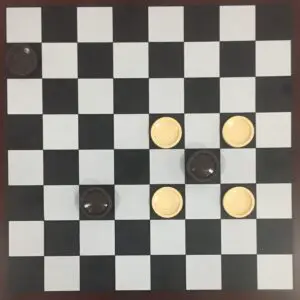
- Kings can move 1 square diagonally forward or backward to the left or right if the square is empty.
- Kings can jump an enemy piece or king on a diagonally adjacent square going forward or backward if the square behind the enemy is empty.
- Kings can jump regular pieces and kings, and they can be jumped by regular pieces and kings.
- Kings can’t jump their own men or friendly kings.
- (Picture) The black king on the right can jump any of the white pieces. The king on the lower left can move to any empty black square next to it. The regular piece on the upper left will become a king when it moves into the opponent’s back row.
- Regular checkers doesn’t use flying kings like in international checkers.
Checkers Rules: Jumping
- Jumping is mandatory.
- Multiple jumps are also mandatory if available.
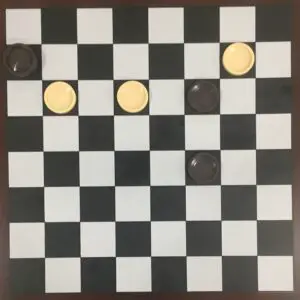
- (Picture) If it’s white’s turn, they must make the double jump that’s available on the right side. If it’s black’s turn, the king on the left must make the double jump that’s available.
- If more than one jump is available, either with one piece or more than one, the player can choose which jump to make.
- A jumped piece or king is removed from the board. If more than one was jumped, they are removed in the order they were jumped.
- A piece can only be jumped once during a sequence.
- You can never jump your own color.
Checkers Rules: Winning & Drawing
- A player wins if they capture all their opponent’s men & kings.
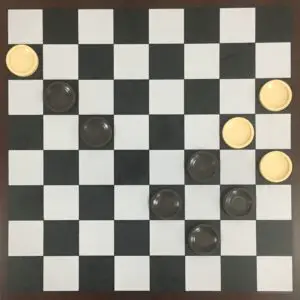
- A player wins if their opponent is unable to move.
- Whoever makes the last move wins.
- A player wins if their opponent breaks the rules twice in a game (see below under Penalties).
- The game is drawn if both players agree to a draw.
- The game is drawn if no regular piece has moved and nothing has been jumped in the past 50 moves (each player has made 50 moves).
- The game is drawn if the board position is exactly repeated more than 3 times.
- (Picture) If it’s white’s turn, black wins because white can’t move.
Checkers Rules: Touching Pieces & Penalties
In casual games, the following rules might not be adhered to. Make sure you and your opponent know all the rules before you begin.
- A player can adjust a piece if they tell their opponent beforehand.
- If a player touches a piece without informing their opponent of an adjustment, they must move that piece.
- If in touching a piece, a player moves it over the corner of the square, it must be moved in that direction.
A player receives a warning if they:
- Fail to make a mandatory jump.
- Touch a piece that has no legal move.
- Make an illegal move or jump—to a wrong square or backwards for a regular piece, or jump in and out of the king row after kinging a piece.
- Remove a piece that hasn’t been jumped.
- Remove one of their own pieces.
- Move out of turn.
A player who commits a violation of the rules for a second time forfeits the game and loses. It doesn’t have to be the same infraction both times.
Basic Checkers Rules Summary
- Light on the right (board orientation)
- Black moves first
- Regular pieces move and jump forward
- Kings move and jump forward and backward
- Jumping is mandatory
- Only enemy pieces & kings can be jumped
- Last move wins (the other player can’t move because they have nothing left or they’re blocked)
Now that you know the basic checkers rules, I hope you enjoy playing this great game. Have fun!